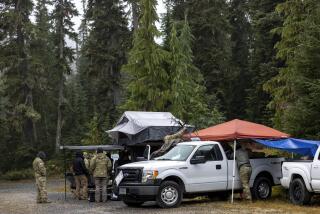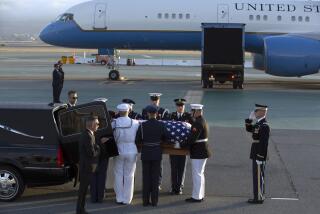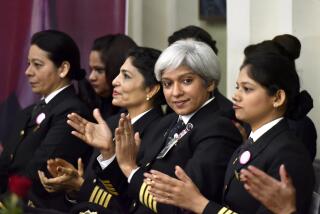Women pilots from World War II to be honored
Reporting from Washington — When World War II beckoned, she was a 24-year-old mother of two daughters, ages 4 and 2. Her husband was a draftsman for Lockheed in Southern California, and her brother became an Army Air Forces pilot.
Carol Brinton longed to become a pilot herself -- “My husband had bad eyes so he couldn’t get in, and I’ve always had a hard time letting my brother get ahead of me in anything,” she said -- but the U.S. military had other ideas.
“They kept saying women couldn’t fly anything bigger than a Piper,” she said.
In 1942, with a shortage of male pilots and a desperate need to muscle up for war, the military changed course.
Famed aviatrix Jacqueline Cochran had been lobbying First Lady Eleanor Roosevelt for a corps of female pilots. Eventually, Gen. H.H. “Hap” Arnold agreed. The Women Airforce Service Pilots, or WASP, program was born, training the first women to fly U.S. military aircraft.
Recruited by newspaper ads and public service announcements, about 25,000 women answered the call. Of the more than 1,800 selected for training, 1,102 graduated.
During the war, they flew 60 million miles in every aircraft available -- Piper Cubs to B-29 bombers.
Prohibited from flying in combat, Brinton and others transported military personnel, towed targets for gunnery practice and tested planes newly repaired or overhauled.
“I’d fly them over their targets,” she said. “The boys went down in the nose of the plane and dropped those bombs on the desert floor. Then I’d go back up to about 15,000 feet and fly back.”
By the time the program was disbanded in December 1944, 38 women pilots had lost their lives. But there were no flags or military honors at their funerals. Their bodies were sent home and buried at their families’ expense. The surviving WASP veterans paid their own way home and melted from history’s pages.
The military decreed that their existence had never been cleared by Congress, and denied them benefits. Arnold’s son Bruce lobbied for their recognition as veterans, a status Congress finally conferred in 1977.
This week, with fewer than 300 WASP members still alive, Congress is bestowing Congressional Gold Medals on all the trailblazing pilots.
So many relatives and fans are planning to attend a two-day celebration -- including Maj. Nicole Malachowski, the first female Thunderbird pilot -- that planners in Washington are juggling sites to accommodate the crowds at Tuesday’s welcome reception and Wednesday’s gold medal ceremony.
One of the pilots attending will be Brinton -- now Carol Brinton Selfridge, 92, and living in Santa Barbara.
“They didn’t even let us join the Army,” said Selfridge in an interview conducted on Skype. “We were private citizens.”
Her journey as a military pilot was made possible by her mother, who agreed to care for her daughters. Her biggest challenge in the early days was finding a uniform to fit her 6-foot frame -- “We all got the same size overalls” -- and getting in 45 hours of flying time before showing up at training camp in Sweetwater, Texas.
She remembers making her solo flight in a rare snowstorm. In the barracks, she shared a bay with five women, including two so short they came up to her armpits.
She thought her greatest asset was her visual depth perception, which allowed her to excel at formation flying. In fact, when she started driving cars, passengers often thought she cut it too close for comfort.
Perhaps her greatest legacy is her granddaughter, Air Force Lt. Col. Christy Kayser-Cook, who followed in her footsteps. When Kayser-Cook was commissioned, two people pinned on her bars -- her great-uncle, who had been an Air Force pilot during the war, and her grandmother.
“She was always ahead of her time,” Kayser-Cook said. “She only got to fly props and she was jealous that I got to fly jets.”
But mostly what the veteran remembers is the adventure of it all. “The idea of flying always sounded wonderful to me. I was tremendously lucky. We had a lot of fun.”
johanna.neuman@ gmail.com
For more photos and videos about Selfridge, visit www.latimes.com/ticket.
More to Read
Sign up for Essential California
The most important California stories and recommendations in your inbox every morning.
You may occasionally receive promotional content from the Los Angeles Times.










